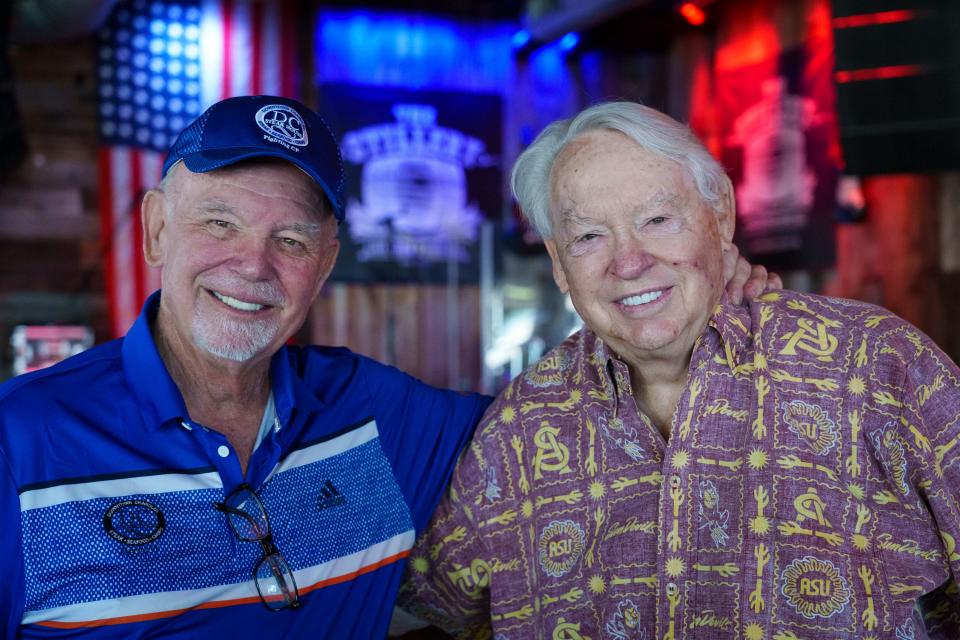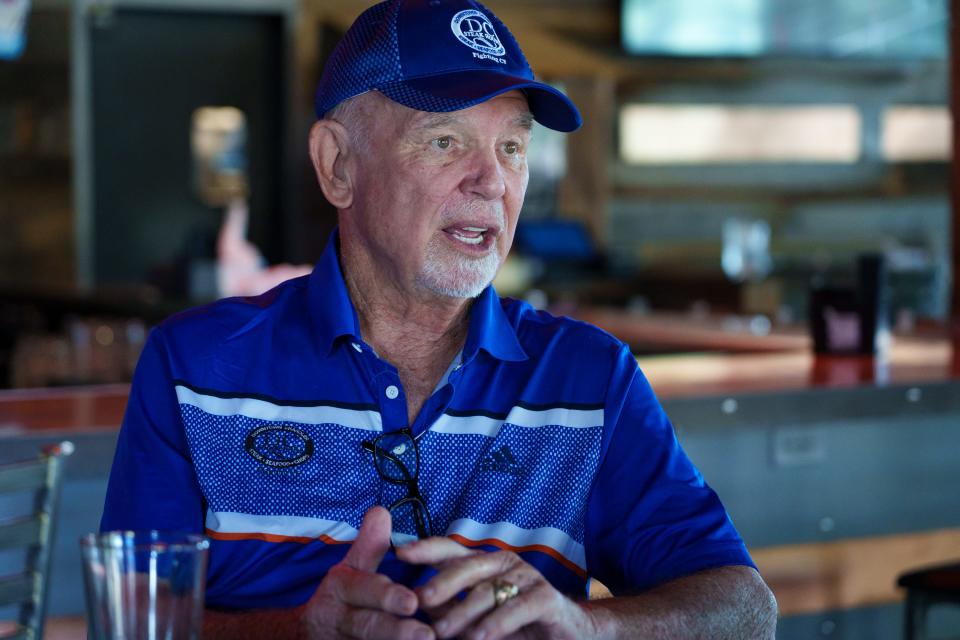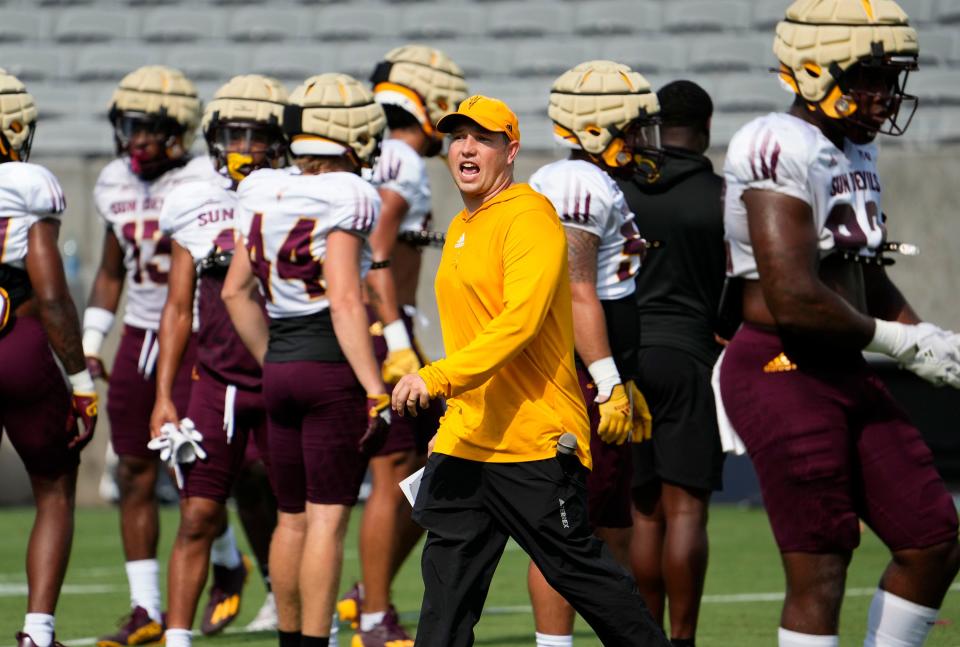'Nappy Hour': Arizona State boosters Nap Lawrence, Fast Eddie drink to a week like no other
Last week began much the same as it had for decades.
The Arizona State football team played its home games at Sun Devil Stadium, was a stalwart member of the Pac-12 Conference and Nap and Eddie tipped back beers.
By the time the wealthy, longtime ASU boosters reconvened at a favorite haunt this Monday, only one of those traditions survived.
“I’m totally satisfied,” Nap said, polishing off a Coors Light.
“Me too!” Eddie replied, explaining he’d just spoken with a billionaire friend from Kansas. “And he is thrilled that ASU is in the Big 12.”
“Is Kansas…” Nap asked, as Eddie laughed and cut him off.
“That’s exactly what I said! Is Kansas in the Big 12? I don’t even know who’s in the Big 12!”

Charles “Nap” Lawrence and “Fast Eddie” Sandidge, both 83, have been best friends since their freshman year at ASU in 1958, when the school first received university status. The Eloy Santa Cruz Valley Union and Chandler high school graduates recognized each other from an incident on the prep football field, in an era before all helmets had facemasks. “He stuck his doggone thumb in my eye!” Sandidge said. They’ve almost seen and done it all in the more than half century since.
Lawrence and Sandidge were part of Arizona State’s original class of four-year graduates in 1962 and made millions in insurance, agriculture and real estate. They are lifelong supporters of Sun Devil athletics, endlessly pouring their faith and fortune into the success of their alma mater, all while hosting regular social events to grow their network and business, a part of the glue that binds the ASU community.
The longtime boosters — and those in their considerable orbit — welcomed The Arizona Republic into their midst, offering a window into their world and mindset as ASU factored heavily in a week of upheaval in college athletics.
“There are times like these, what they call ‘Nappy Hours,’” said Ronnie Byars, 73, a local businessman and ASU supporter who’s so well known in Chandler he said the mayor even calls him “mayor.”
“They’ll invite coaches, players and stuff, so everyone else can meet these people. We’ve met all the new coaches we have. They’ve all been here, as soon as, before they even basically got hired. They were here.”

Lawrence said he’s donated about $9 million to benefit ASU over the years, including a $1 million pledge to the Sun Devil Collective during football coach Kenny Dillingham’s introductory press conference in November, earning a standing ovation.
And he and Sandidge said they’ve helped ASU coaches recruit more than 100 athletes who went on to play in the NFL, NBA and Major League Baseball.
“We wouldn‘t have a football team without Nap Lawrence...” Dillingham said on Thursday as ASU opened three days of practice at Camp Tontozona. “Point blank, zero, we would not have a football team without Nap Lawrence, so to see him out here, that dude‘s as valuable to the program as anybody on the field. I told him the other day, ‘Come out on the field, do whatever you want, without you we don‘t have a team.’”
Lawrence said he traveled on recruiting trips with the late Frank Kush in the 1960s and ’70s to sell parents on the young football coach, presenting him as a father figure while Kush rallied the kid, and later hired ASU athletes to work on his farms.
“People would always ask my dad, ‘What’s your secret to being such a great, winning coach?’ And he goes, ‘Get good players,’” said Danny Kush, who kicked the game-winning field goal to defeat Nebraska in the 1975 Fiesta Bowl, securing an undefeated, 12-0 season and No. 2 ranking in the final AP poll, the Sun Devils’ best finish ever.
“There are some phenomenal players, and there have been since the ‘50s, ‘60s and ‘70s, players that have come out of the state of Arizona. And with Nap’s connections down in Eloy and the southern part of the state, and Fast up in the Scottsdale area, they helped find kids that really had a desire to play.”
Joe Palmisano, an ASU grad and co-owner of Peddler‘s Son produce delivery company, said Lawrence and Sandidge set an example for other alumni.
“They‘re building a legacy for us younger people, or middle-aged people, to continue to give to the program,” Palmisano said, “and make ASU a program to reckon with from football, basketball, baseball to the Olympic sports.”
Looking back: Arizona State leaving rich Pac-12 history behind in Big 12 expansion move
‘Money, money, money, money’
Lawrence and Sandidge have seen the Sun Devils move from the Border Conference to the Western Athletic Conference in 1962, to what then became the Pac-10 in 1978 to their acceptance in the Big 12.
But last week had been like few others.
On Wednesday, for the first time, ASU sold the naming rights to Sun Devil Stadium, rebranding the venerable venue as “Mountain America Stadium, Home of the Sun Devils,” after reaching a 15-year deal worth more than $50 million with the Utah-based credit union, Sports Business Journal reported.
On Friday night, Arizona State joined Arizona and Utah in announcing a move to the Big 12 beginning in the 2024-25 school year, following the lead of Colorado a week earlier, as the Pac-12 crumbled over television money and exposure. Oregon and Washington bailed to join the lucrative Big Ten earlier in the day, following the lead of Southern California and UCLA last year.
“That’s what it seems like it’s all about lately: Money, money, money, money,” Sandidge said, discussing the impact of TV contracts on the college sports landscape. “That’s where the money is from. That’s for sure.”
Of course, conference realignment has long been about money.
Lawrence recounts how ASU and Arizona joined the Pac-8 at the behest of USC and UCLA, which at the time wanted a share of the Arizona schools’ sizable ticket revenue and threatened to leave the conference unless expansion was approved.
“They could have called it the ‘Six Pac,’” Lawrence laughed.
“I know Frank Kush and those guys did not want to switch to the Pac-10 because they were King Kong where they were at,” Sandidge said, “and they knew competing with Southern Cal and UCLA was going to be a lot tougher than Wyoming and New Mexico.”

Now, Lawrence and Sandidge wrap their hands around frosty pints, weighing traditions versus finances versus athletic success.
The Big 12’s media rights deal with ESPN and Fox, struck last year, will pay each school an average of about $32 million per year through 2030-31, about half the average annual media rights fees collected by Big Ten and SEC schools, but far more than the $23 million per year reportedly offered to Pac-12 schools by Apple. The tech giant proposed an online, subscription-based streaming service, offering limited exposure compared to network TV.
Pac-12 Commissioner George Kliavkoff presented this option to conference presidents last week, on Tuesday, and by Thursday night an Arizona Board of Regents meeting ended with ASU President Michael Crow the only one advocating for the Sun Devils and Wildcats to remain in the Pac-12.
Crow had long supported former Pac-12 commissioner Larry Scott and the doomed Pac-12 Network, and prized ASU’s affiliation with West Coast academic heavyweights like Cal and Stanford. But when Oregon and Washington didn’t show up to the Pac-12’s virtual meeting Friday morning, Crow told reporters this week, he knew the conference was no longer viable.
Small town to ASU: How Jalin Conyers became a major college player and NFL draft prospect
“He’s a loyal son of a gun,” Sandidge said. “That’s pure loyalty. But looking at the big picture and the indecision, he made the right decision for us to move.”
The widening financial chasm between Big Ten and SEC schools and other Division I athletics departments underscored not only the change in conference, but ASU’s decision to sell stadium naming rights, joining about a dozen other universities that have done so nationwide.
“We thought it was the brightest move they could have made,” Lawrence said. “I love the name Sun Devil Stadium. I’ll probably always refer to it as that. But (it was) not in the best interest to say, ‘No, we don’t need that (money).”
‘Coaches that know how to sell Arizona’
ASU and Arizona never entertained the idea of splitting up and playing in different conferences, Crow and Arizona President Robert Robbins told reporters this week, a notion Lawrence and Sandidge described a week earlier as “inconceivable.”
The Territorial Cup is the oldest rivalry trophy in college football, dating to 1899, and the game itself has been played every year since the end of World War II.
“It is the event of the year of all games played in the state of Arizona,” Lawrence said. “Including the pros. And it’s a bitter rivalry. They cost us a national championship when we won the Rose Bowl.”
Sandidge nevertheless described New Year’s Day 1987, as the “most exciting day of my life, other than the birth of my child.”
“Nap and I were sitting on the 50-yard line watching ASU, this little maverick school from Arizona, win, beat Michigan, and we were both crying,” Sandidge said. “It was just so exciting.”
“And what made that super — super — was the fact that our entire offensive line, which is who basically won that game for us, was from Arizona kids of several (ethnicities),” Lawrence said. “It worked out phenomenal.
Eyes on Texas: Big 12 move will enhance ASU football's recruiting efforts in Lone Star State
“We had some of the best players in America that year, and Arizona is probably now producing the same caliber of player, but we’re 20 times larger than we were then. So we now have coaches that know how to sell Arizona. This could possibly be the best staff ever in ASU football.”
Dillingham, 33, is a Phoenix native and 2012 ASU graduate who began his coaching career as an assistant at Chaparral High School. He joined the Sun Devils as an offensive assistant in 2014 and was most recently the offensive coordinator at Oregon before returning to the desert to lead his alma mater.
“Everybody absolutely loves Kenny,” Sandidge said, “and I think (ASU athletics director) Ray Anderson, by making that choice, really, really, really helped ensure his success at ASU. His continuity. ... We’re going to win a lot more games than we lose next year! Kenny is going to succeed immediately.”

Dillingham’s tenure follows the dismissal of Herm Edwards, who left the program under the cloud of an NCAA investigation and possible sanctions for allegedly hosting recruits on campus during the pandemic.
Lawrence said he’s never broken recruiting rules, though he acknowledged decades ago he once received two years of NCAA probation for allegedly offering to give a recruit a boat, a farm and a Cadillac. Which he denies.
“All a booster means is a great fan,” Lawrence said. “We’ve got thousands of them at ASU, and all we have to do is get a little help from all of them and then we’ll be in as good a shape as anybody else for all types of money that is legally now given to them.”
End of an era: What to know now that Arizona, Arizona State are in the Big 12
One of Lawrence’s grandsons, Cohlton Kieffer, is a development officer for the Sun Devil Club, which raises money for ASU athletics. Another grandson, Carston Kieffer, is a freshman kicker on the team.
Those on Dillingham’s coaching staff with deep Arizona roots include assistant head coach and special teams coordinator Charlie Ragle, who led Chaparral to three consecutive state titles and was most recently the head coach at Idaho State, and running backs coach Shaun Aguano, who led Chandler to four state titles, joined ASU in 2019 and served as the Sun Devils’ interim coach late last season.
“These guys know, and they’re totally respected in the state of Arizona,” Sandidge said.
“There are thousands of fantastic football players out there, and so many of these kids that are touted as being the best fall flat on their face. It would make it easier to win if you had more money. No doubt about it. But I don’t think it’s necessary to be a billionaire to be successful. I know a lot of billionaires that are unhappy people. So money doesn’t make you successful.
“What makes you successful is winning. It’s a lot of fun when you win.”
This article originally appeared on Arizona Republic: ASU boosters Nap Lawrence, Fast Eddie on Big 12, stadium naming rights

